Sound and Fury:
A review of Armored Thunderbolt: The U.S. Army Sherman in World War II, by Steven Zaloga
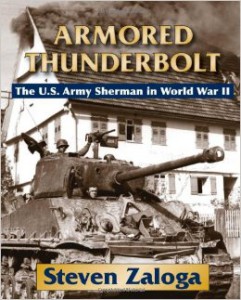 Fury, the 2014 Brad Pitt war movie, opens with some grim statistics. According to the movie, something like 10 Shermans were destroyed for every German tank and American tankers were grossly outmatched in equipment. As happens so often, here pop culture oversimplified and exaggerated history for the sake of drama. The truth, as portrayed in Steven Zaloga’s excellent Armored Thunderbolt, is a lot more complex. True, the Sherman was totally outmatched in a one on one fight against a Tiger or Panther, but those battles were so rare as to be negligible. Zalog’s thesis is that the Sherman, while flawed and somewhat outdated by Normandy, was a solid design whose flaws outshone its virtues in the larger perspective. Through painstaking analyses, Zaloga shows that casualty figures, individual anecdotes, and popular culture are misleading and show the Sherman as far more vulnerable than it was in real life. Understanding the true history of armored warfare is important to make future installments of Unity of Command more realistic.
Fury, the 2014 Brad Pitt war movie, opens with some grim statistics. According to the movie, something like 10 Shermans were destroyed for every German tank and American tankers were grossly outmatched in equipment. As happens so often, here pop culture oversimplified and exaggerated history for the sake of drama. The truth, as portrayed in Steven Zaloga’s excellent Armored Thunderbolt, is a lot more complex. True, the Sherman was totally outmatched in a one on one fight against a Tiger or Panther, but those battles were so rare as to be negligible. Zalog’s thesis is that the Sherman, while flawed and somewhat outdated by Normandy, was a solid design whose flaws outshone its virtues in the larger perspective. Through painstaking analyses, Zaloga shows that casualty figures, individual anecdotes, and popular culture are misleading and show the Sherman as far more vulnerable than it was in real life. Understanding the true history of armored warfare is important to make future installments of Unity of Command more realistic.
Immediately after the War, the Sherman was portrayed quite differently in pop culture. It was hailed as a war-winning weapon like the venerated B-17, the P-51, and the M1 Garand. It was only later, when books like Belton Y. Cooper’s Death Traps (based largely on misleading anecdotal evidence) came out, that the Sherman became viewed as an outmatched failure. The truth is more complex than either of these extreme views.
Zaloga goes a long way to acknowledge the Sherman’s flaws. Because of bureaucratic inertia and US Army leaders’ decisions that, for the sake of logistics and increased production, new designs were to only be entertained once there was a proven “battle need,” the Sherman was kept in service without important upgrades or a replacement for too long. During the Sherman’s first combats with the British Eighth Army in North Africa, the Sherman, with its good armor and relatively high velocity 75mm gun was hailed as a formidable improvement over Britain’s own indigenous designs. More importantly, the Sherman was reliable and plentiful, whereas British tanks were prone to breaking down and could be produced only in smaller numbers. Though the Sherman took a beating in North Africa after Torch and struggled in Sicily and Italy and some flaws were evident (most notably the tendency to catch fire), newer German tanks like the Tiger and Panther were so rare that there was no pressing “battle need” to do more than upgrade the M4.
Furthermore, the US Army had misguided doctrine regarding tanks. According to the “tank destroyer doctrine,” Shermans and other tanks were intended for infantry support. Enemy armor, when encountered, was supposed to be handled by anti-tank guns and self-propelled tank destroyers like the M10 Wolverine. Thus, there was no need for the Sherman to have the heavy armor or high velocity guns needed to engage enemy armor. In practice, though, the Sherman formed most of the spearheads and tank destroyers were often not available when enemy tanks were encountered. Meanwhile, the open-topped tank destroyers were poorly protected and armed against infantry. Rather than phase out tank destroyers and upgrade the Sherman to handle both roles, armored formations muddled along with specialized vehicles doing each other’s job in addition to their own.
The Sherman had many virtues to offset its faults. First and foremost, it was plentiful. The Sherman, unlike fiddly and highly complex German and British tanks, was easy to manufacture and field en masse, a lot like the Soviet T-34. Unlike the T-34, which got the excellent 85mm gun and improved turret, the Sherman was not sufficiently improved until the last days of the war.
Secondly, the Sherman was ubiquitous. Because the M4 was reliable and fuel efficient, it was highly mobile on an operational and strategic level. The Sherman was easy to ship across the ocean, fuel efficient, and rarely broke down when traveling long distances over roads. Meanwhile, Germany’s damaged rail system could barely shuttle tanks back and forth and, when forced to travel on roads, the Panther and Tiger’s unreliable and overloaded drive systems frequently broke down – if the fuel guzzling panzers didn’t run out of scarce petrol first.
The Sherman was also an excellent infantry support tank, even without upgrades. The Sherman’s medium velocity 75mm gun carried a larger explosive charge than the upgraded 76mm or the Panther’s long 75. The M4 also had two or sometimes three .30 caliber machine guns, plus the formidable M2 .50 caliber carried on top. The base design was also highly adaptable, being used to mount howitzers, flamethrowers, anti-mine countermeasures, bulldozer blades, and more. The British upgraded some of their Shermans with their excellent 17 pounder gun which could take out even the heaviest German tanks. Later, the Israelis modified their Shermans to mount high velocity 105mm guns and kept them in service well into the Cold War. Thus, it’s easy to see how the US could have had a superb universal tank much sooner had the Ordinance bureaucracy been less stubborn.
The most revelatory part of Armored Thunderbolt is what Zaloga’s research reveals about armored warfare as a whole. First off, the casualty ratios between Shermans and German tanks are greatly misleading. In almost every case during World War II, the attacker lost more tanks than the defender. The US Army was almost always on the offensive from the moment it landed in North Africa in 1942, therefore the Wehrmacht always had the better casualty ratio, regardless of the relative quality of their tanks. On the occasions when the Germans were on the attack against the Sherman, the numbers were reversed. In tank vs tank combat, victory went not to the better armor or gun or even the best crew, but to the tanks that spotted and fired upon its target first. This advantage of shooting first almost always went to the defender.
Furthermore, the Sherman very rarely encountered Panthers or Tigers, in the overall scheme of things. More often they faced Panzer IVs, Sturmgeschutz assault guns, tank destroyers, anti-tank rockets, and especially anti-tank guns. When ambushed by these weapons, the Shermans were almost always damaged or destroyed in greater numbers than their foes. When the Wehrmacht attacked and had to face Shermans, American TDs, bazookas, and anti-tank guns, the shoe was on the other foot. And, versus infantry weapons or the more common tanks and tank destroyers, the Sherman’s main gun was more than adequate. With the extra HE capacity mentioned above, the Sherman was in some way even better at fighting their most common opponents, AT guns, than the Panther.
The Sherman, as researched and portrayed by Zaloga, was an excellent weapon of war. On a strategic and operational level, US armored formations were more mobile, more adaptable, and arguably just as formidable as their depleted, broken-down German opponents. A platoon of Shermans on the spot trumped a broken down Tiger 50 miles away every time.
What does this have to do with wargames? I think Zaloga’s book shows that there’s a lot more to war than bigger guns and thicker armor. We, as gamers, tend to fetishize stats – armor thickness, muzzle velocities, casualty ratios – because they’re sexy, easy to access, understand, and compare. The truth of WWII armored warfare was far more complex and difficult to break down into tidy blocks of stats. As the 2×2 team prepare the next Unity of Command game, they are doing their research and preparing to incorporate more insights into the reality of warfare as it was, while still making the game as accessible and fun as ever. As a fan of the series and of history, I’m excited to see what they’ll come up with.

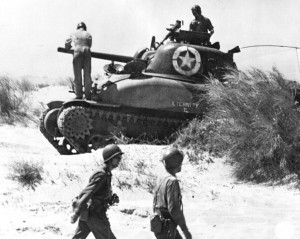
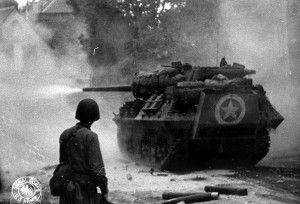
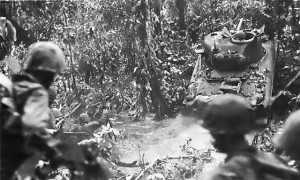
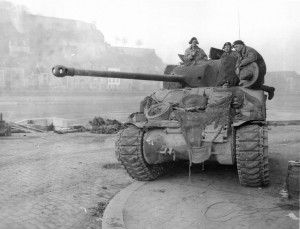
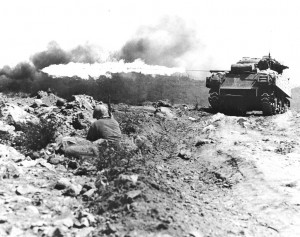
4 Responses to Sound and Fury: A Review of Armored Thunderbolt by Steven Zaloga